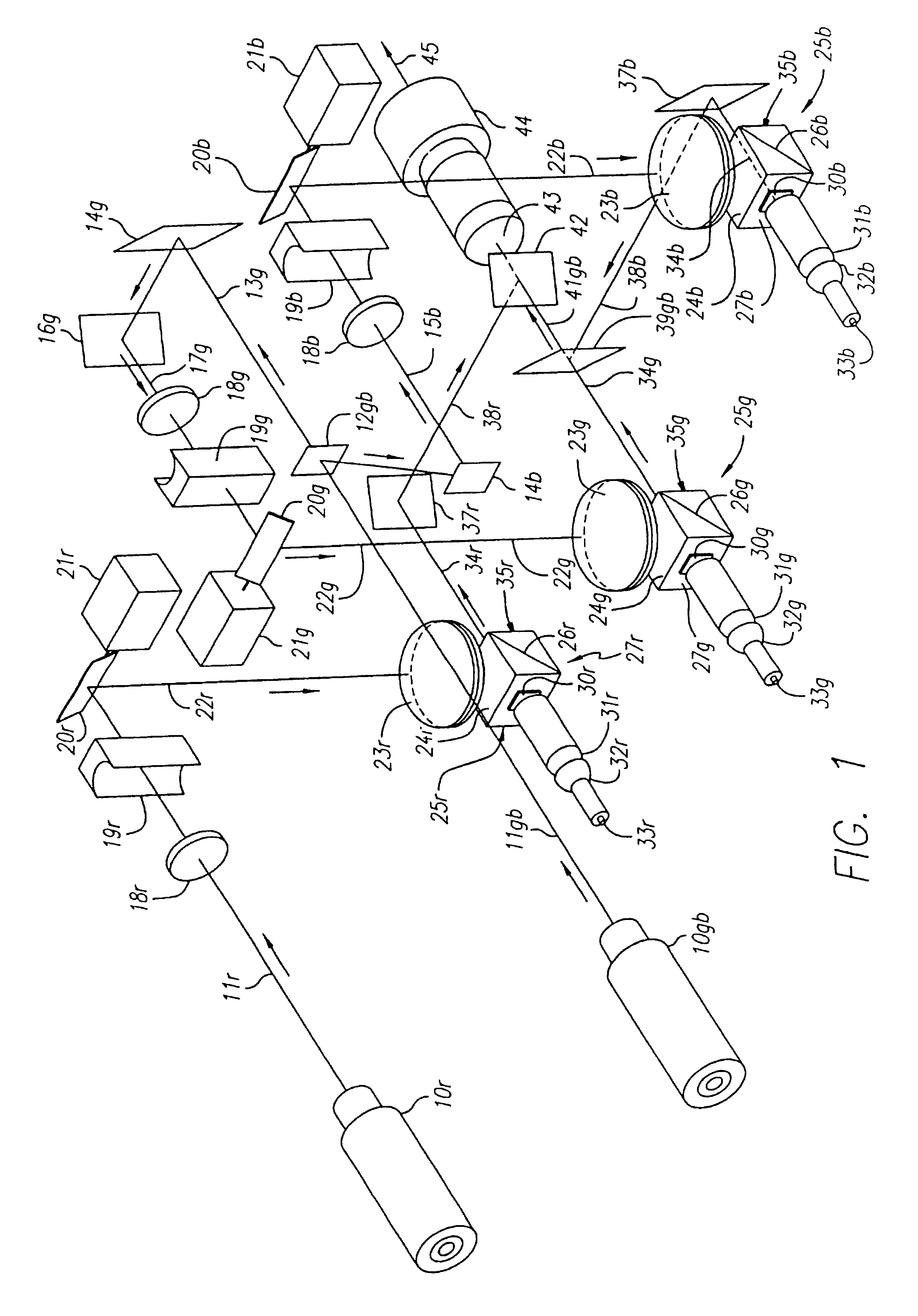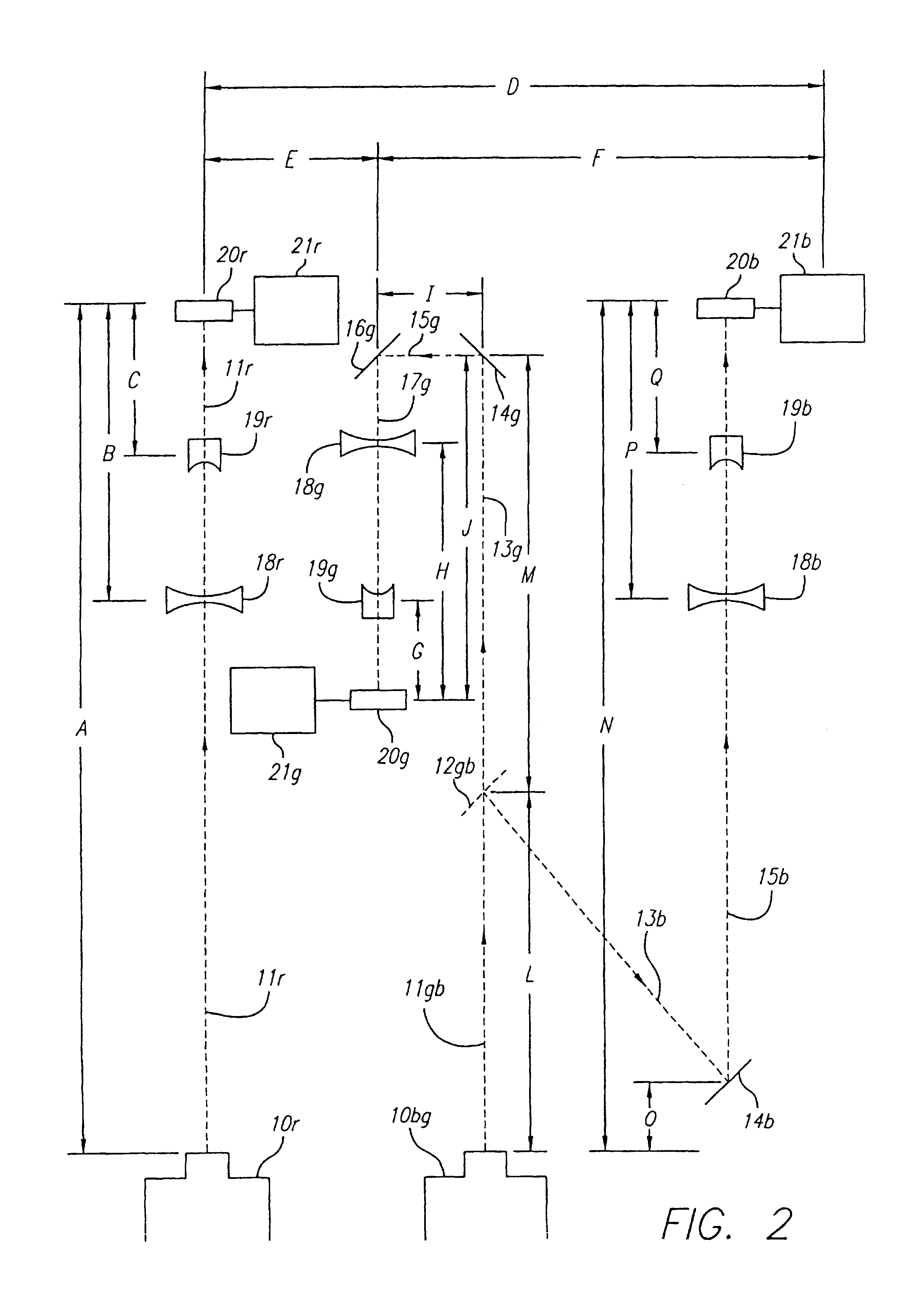Indeed, several powerful large international companies have attempted—at monumental cost—to develop such equipment for market.
In such transactions it is well understood that some conversion inefficiency is unavoidably involved as a sort of tariff—in other words, that a sizable fraction of the electrical energy used will go into invisible
forms of energy such as heat, or near-
infrared and
ultraviolet radiation.
It can be dismaying to pay for many times the amount of electrical energy used—even that which is directly used to make visible light, setting aside consideration of the conversion efficiency discussed above.
Such efforts, however, complicate and compound the management of heat thrown off due to those same conversion inefficiencies considered above.
In comparison with a typical
arc lamp or like device, a laser is vastly more favorable with respect to the amount of heat, the temperature involved, and the difficulty of collection.(ii) brightness—With most types of light sources, increasing the amount of light available calls for fabrication of a source that is scaled up in all three dimensions, more or less equally, and therefore greatly complicates the process of collecting the light and drawing off heat.
Such undesired spill corrupts areas that should be dark.
With such other sources, each distinct beam carrying a separated spectral segment is already
broadband, either complicating or degrading the effectiveness of
all optical effects or manipulations.
As I now understand, however,
laser beams when used to project images in such a way as to obtain this effect are not focused at all.
For reasons that will appear after I have introduced my invention, however, these effects should never come into play in a laser-based
system properly designed and assembled for image projection.
Some of this value has been actually achieved in some vector systems, as will be explained below, but the much greater potential for raster images has not been realized in practice heretofore.
Such a
system cannot provide accurate infinite sharpness of a full-
color image, as introduced above, since Korpel's separately swept individual-color beams emanate from spaced-apart points (possibly even spaced-apart projection lenses) and can therefore accurately converge to form a registered image only at a preselected plane.
It appears that these systems may have considerable promise, but are not to be found in the marketplace.
It would seem that for these devices with present-day available components the laser power at certain needed wavelengths, or the modulation response speed, or the overall economics, or combinations of these considerations, are inadequate for realistic commercial exploitation.
Though capable of moderately
high contrast (over 300:1 in certain military projectors),
high resolution, reasonably good
color saturation, and infinite sharpness, this type of
system is subject to important limitations and also certain qualifications as explained below.
Unfortunately the compromises that enable achievement of the favorable parameters listed above also reduce, to an unacceptably low level, the light efficiency of the modulators and the system in general.
The only laser projectors built in this way that actually operated to produce excellent
image quality were
military systems that required extremely large, high-power, expensive lasers.(ii) low bandwidth—Another element that suffers in these systems is the capability to follow rapid action in a scene.
It would not be possible to operate a one-raster-line-at-a-time modulating system with any other
beam shape.
It would not be possible to operate a one-raster-line-at-a-time modulating system without some sort of
stepper.
Speckle is highly undesirable in image projectors for displaying ordinary pictures (movies, television shows etc.) because it pervades the images and distracts from the informational or dramatic content of the show.
Heretofore, however, actual equipment called into service for accomplishing this has fallen far short of the elegant.
One of his systems is “a
spinning diffusion plate” which works at “transverse plate velocities in excess of a few centimeters per second” but suffers from “transmission inefficiency (˜50%) , .
Another system is a “flowing fluid diffuser” using “a highly turbid fluid”, suffering from “
low transmission efficiency with the inconvenience of a pump and associated plumbing.” A third, relying not on flow but on “
Brownian motion”, Hargis rejects because “its transmission efficiency is limited, compared with what presently appears to be the best available system described below”.
Provision of his illustrated device, plus a system of electromagnets and associated
electrical drive, may not be expensive but it is certainly elaborate and surely diffuses—and thus randomly redirects and wastes—expensive laser energy.
They add otherwise unnecessary mechanical or electromechanical equipment, and more importantly they subtract light.
The choice of
laser light at 610 nm for red thus has complicated repercussions—particularly since the cyan light in an
argon-laser beam amounts to some forty percent of the total power or energy in the beam.
Discarding that large fraction of the beam power is a profligate waste, when a major challenge in the
laser projector field is finding enough energy at a reasonable price to form an adequately bright large image.
Whether because television phosphors lacked the capacity for deeper red or because of their need for greater brightness, present laser-
projector workers stress the
NTSC-based luminance chart and the 610 nm red options—and thus forsake the broader color
gamut available in both film and computer monitors, as well as the ample beam power readily available in the cyan lines.
In the opinion of this writer, reliance on tunability is a handicap because of the extra operator attention which it demands, as well as the high cost of tunable mirrors and other needed paraphernalia.
Dye lasers are considerably less user-friendly than gas lasers, on account of their requirements for management of an additional pumping stage at the front end and mixing stage at the back.
In most cases they also consume profligate amounts of extra energy in generating light at frequencies that are not wanted but merely needed for purposes of subtraction or addition to obtain desired frequencies.
It is highly questionable, however, in a cost-conscious commercial environment, for example a light-hungry
projector system for driving a monumental IMAX®-style screen or an outdoor-spectacle system which projects images onto, actually, monuments and other structures.(iii)
solid state—These devices may in the end become the only sources that make economic sense, for use in my invention as well as other types of systems.
These electrodes are nominally transparent, and indeed are not readily visible in displays of modest size, such as for instance less than five feet along a
diagonal.
These patterns are distracting and intrusive, leaving LCD modulation essentially unusable for high-quality imaging in theater and outdoor applications, unless all of the audience is at a very great distance from the screen or other projection medium.(iii) no infinite sharpness—Also a drawback for such large-scale applications is the fact that these LCD units fail to preserve the laser property, described earlier, of maintaining sharp imaging at widely varying projection distances.
Both types of usage are discussed below.(iii) image projection using incandescent-lamp sources—Regardless of other optical conditions, broad-spectrum conventional light sources cannot provide the infinite-sharpness characteristic.
Accordingly these systems are incapable of the earlier-mentioned special-effects applications that rely on infinite sharpness.(iv) full-frame—Most of the Hughes patents describe operation with the high-intensity “reading” or output stage of the LCLV modulator flooded continuously by projection light, or in other words all illuminated at once.
Subject to contrast limitations, the projection medium would be substantially dark in regions corresponding to writing-stage regions not illuminated by the pen-light.(v) poor energy economics, and brightness nonuniformity—The full-frame LCLV Hughes system is, however, subject to several drawbacks.
Only a small fraction of this omnidirectional
radiation can be effectively captured for guiding into the LCLV, and the remainder becomes a source of heat-management problems.
Second, the light collected from a high-intensity source is typically nonuniform across the frame in which that light is collected.
This too can be mitigated, and in conventional ways including use of frosted (i.e., diffusing) elements—but such solutions further scatter
optical energy with only limited directionality, and so inevitably further aggravate the already unfavorable collection geometry.
Special lensing, too, may be used to reduce central bright spots, but at yet-additional cost—both monetary and thermal.
The costly or even precious high-power
light beam, however, is directed indiscriminately to the entire frame, including mostly unreceptive regions that are not being written at any given moment.
Thus the unfavorable factor is not on the order of thousands, only on the order of four or ten—but still distinctly unfavorable.
Fourth, yet more
energy loss is incurred in beam masking to fit the image shape & projection frame.
Thus 36% of the energy in a circular beam is wasted in masking to a square frame.
In going to the popular widescreen nine-by-sixteen format 974 (FIG. 28) the lost fractions 975 are nearly 46%, close to half of the
optical energy in the circular beam.(vi) polarization analyzer—Now turning from energy losses somewhat in the direction of performance, the intrinsic
contrast ratio of an LCLV although high is far from perfect, particularly since polarization
extinction for broad-spectral-band light is hard to control.
Despite these yeoman efforts, it appears that Hughes has never used the scanning-slot system commercially.
Perhaps this is due to the difficulty of forming a white-
light source beam into a very shallow, very wide slot-
shaped beam, without discarding so much light that the overall system is unacceptably inefficient and impractical.
As mentioned earlier, the transmissive LCD devices are objectionable for very-large-format projection because of conspicuous
electrode patterns which they display.
These problems are just as important with laser sources as with the Hughes white lamps.
Likewise the problem of speckle in systems using LCLV modulators is never taken up by Minich in those patents.
It is substantially impossible to operate a laser / LCLV projector without addressing this obstacle.
Minich furthermore fails to address the desirability of infinite sharpness, although this represents a major application for laser projectors.
All in all, it appears that the disclosures in the '263 Minich patent are conceptual rather than practical.
No product or publication has revealed how to provide infinite sharpness, or otherwise how to project images on irregular projection surfaces having dramatically varying projection distances.
No teaching in the art has revealed how to defeat speckle without adding elaborate equipment appendages that subtract light.
The art has never resolved, in marketplace terms, the problems of brightness, contrast, energy efficiency, masking, or illumination of nonwriting regions which Henderson, Schmidt and Gold attempted to address.
As can now be seen, the related art remains subject to significant problems, and the efforts outlined above—although praiseworthy—have left room for considerable refinement.
 Login to View More
Login to View More  Login to View More
Login to View More 


